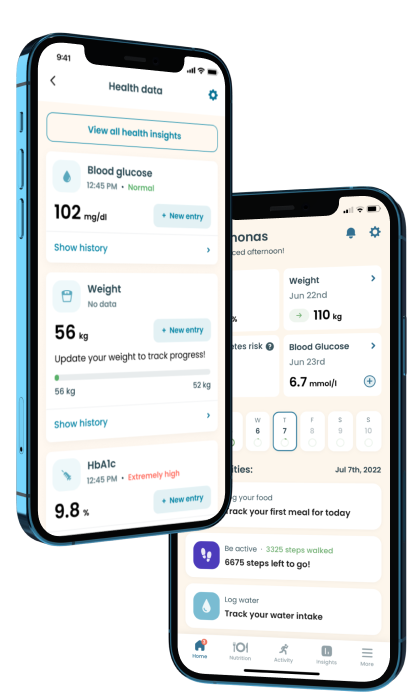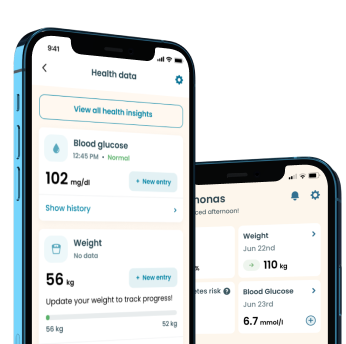Garri and Diabetes

Good
56
357 kcal
If you're a person living with diabetes, you already know that you have to be very careful with what you eat. Since diabetes isn't a sickness that can be cured but only managed, you've got to be very careful with managing it.
The best way to do that is to be careful about what you eat. To be careful about what you eat, you've got to interrogate your present meal choices and really ask yourself whether they are good for you.
In today's article, we'll be interrogating the relationship between garri and diabetes. We'll be seeing whether people with diabetes should add it to their diets, or remove it from their diet.
Nutritional value
- Protein 6.9 g
- Carbohydrate 83 g
- Fat 0.3 g
- Fiber 5.9 g
- Sugar 3.5 g
- Cholesterol 0 g
What Is Garri?
Garri is essentially an edible processed cassava product. It is one of the most popular Nigerian foods and is made with the flour obtained from processing the roots of freshly harvested cassava. Cassava is usually cultivated in tropical and subtropical areas.
While garri can be eaten in several ways, it is mostly made by mixing the flour with hot water to form a dense paste. This paste is then eaten with soup or sauce of almost any kind.
Garri is really popular in West Africa, especially in Nigeria where it is seen as a cultural meal. It's also popular in countries like Cameroon, Benin, Togo, Ghana and Liberia.
Garri is made entirely from cassava tubers. These tubers are peeled washed and crushed to create a mash. That mash may then be mixed with palm oil, and then placed in a porous bag.
The bag is then placed in an adjustable press machine for about three hours. This is done to remove the excess water in the mash. Once the mash is dried, it is then sieved and fried in a large frying pot. The resulting dry cassava granules are what is called garri. These granules could then be pounded or ground to make a fine flour that could be used to make the garri paste.
Interestingly, the fact that garri is fried doesn't make it one of the many fried foods that have a lot of bad cholesterol.
Take a quiz
Discover what Klinio app can do for you
Healthy diabetes meal plan crafted just for YOU

Personalized workouts with no equipment needed

Track your progress with smart tracking tools

Dishes Garri Can Be Made With
The most common meal that garri can be made with is called eba. Eba is essentially a dense paste that is made by soaking garri in hot water, and kneading it with a baton till it becomes a smooth and stiff paste. This meal is often served with several soups or sauces. Some of the soups garri may be served with include egusi soup, Banga soup, vegetable soup, and a host of others.
Garri can also be made into Kokoro, which is popular Nigerian snack food. However, Kokoro isn't made with garri alone. Instead, it is made from a paste of maize flour, which is mixed with garri and sugar. That paste is then deep-fried to make Kokoro.
Garri could also be soaked as it is. Soaking the flour in water, and then adding sugar or milk to it makes it edible. In fact, it can be soaked and taken like that, without any other ingredients. However, the garri used for this is called Ijebu garri, as it has a pleasantly sour taste that makes the garri edible. Other kinds of garri asides from Ijebu garri can also be used for soaking.
Cassava Plant Nutrients
It's impossible to talks about the nutrients of garri without talking about the nutrients of the cassava plant since that's all garri is made from.
A 100 gram serving of cassava contains about 191 calories. About 84% of these calories come from carbs, while the rest are from protein and fat. That serving also has some naturally occurring dietary fibre, vitamins and minerals.
Cassava flour is also really high in vitamin C, which is a really important vitamin that acts as an antioxidant that enhances immunity and improves collagen production.
It's also rich in copper, which is a mineral that is necessary for neurotransmitter synthesis production. It also enhances immunity too.
Here is a complete breakdown of the nutrients found in 100 grams of cassava plant:
Calories: 191
Protein: 1.5 grams
Fat: 3 grams
Carbs: 40 grams
Fibre: 2 grams
Potassium: 6% of the DV (Daily Value)
Magnesium: 5% of the DV
Niacin: 5% of the DV
Vitamin C: 20% of the (DV)
Copper: 12% of the DV
Thiamine: 7% of the DV
Folate: 6% of the DV
Vitamin B6: 6% of the DV
The Relationship Between Garri and Diabetes Mellitus
Diabetes cannot be cured. However, the illness can be managed through the use of modern medicine. However, what most people fail to realize is that eating the right food — whether they are traditional foods or something you can get from fast-food restaurants, is the best way for diabetics to manage their blood sugar.
Interestingly, garri can actually help you live a healthy life as a diabetic and help you control your blood glucose levels.
The idea that garri can help people combat a high blood sugar level is one that has gotten really popular. One reason for that is a 1994 article for the journal Acta Horticulturae, where A.O. Akanji argues that Cassava could cause diabetes mellitus.
Fortunately, the available evidence hasn't been able to prove that. In fact, several studies since then have proven that there is a low occurrence of diabetes among people who eat cassava.
One study that was published in December of 2006 followed the lives of 1,381 subjects. Interestingly, none of the subjects had diabetes, even though products from the cassava plant made up about 84 per cent of their caloric intake.
Another study published in 1992 argued that Tanzanians who ate cassava regularly didn't develop diabetes mellitus at the same rate that people who rarely ate it did.
Several studies have proven that Cassava is a food crop that is a very valuable source of energy for people in sub-Saharan Africa.
To further understand the relationship between garri and diabetes mellitus, it's important to look at the glycemic index of the food crop.
Glycemic Index And Glycemic Load
Glycemic index is a rating system that helps people look at how well or how badly a certain food will affect a person's blood sugar level.
The glycemic index is essentially the ranking of a food based on the postprandial glucose response of the body to that food, compared with a reference food.
If a food has a high glycemic index, that means it produces a high concentration of blood glucose and contributes to insulin resistance. This could make the body start developing diabetes.
However, it's important to note that glycemic indices are usually seen through the context of the carbohydrate content in the food consumed. This means that carbohydrate foods taken in high quantities will naturally have a high glycemic index.
A related metric to glycemic index is glycemic load. The glycemic load of a food is gotten by multiplying its glycemic index by the carbohydrate content of the consumed serving.
Low gi foods are quite useful if one wants to address things like high blood glucose. That's because meals with a high glycemic index contribute to an increase in blood glucose, since they may increase insulin resistance in the body. Of course, this resistance is associated with an increased risk of chronic diseases like high blood pressure, obesity and diabetes mellitus.
The glycemic index of cassava is pretty low and is around 46. That makes cassava a low glycemic index food.
This means that it is a lot more likely than some food crops to cause a significant rise in the blood sugar levels of diabetic patients.
If you're a diabetic patient, cassava flour would be a healthier choice than white potatoes for example. That's because they have a high glycemic index of 85, which is around double that of cassava flour.
Eating cassava, for example, would be better than eating sweet potato or something made from wheat flour, since they have a glycemic index of 54.
However, it's also important to note that the process of fermentation increases the glycemic index of cassava. As such, garri usually has a much higher glycemic index than cassava.
Health Benefits Of Garri
If you decided to eat cassava regularly, in the form of garri, what are the benefits you're likely to enjoy? Will it help you lead a healthy lifestyle, or will it let you fall into ill health?
Let's find out.
Good For Diabetic Patients
Since cassava has a relatively low glycemic index, it's really the perfect meal for diabetic patients. However, diabetic patients must understand that this doesn't mean they can eat garri with abandon.
The glycemic index of a food is important — but so is the portion size and caloric intake. If diabetics would like to reduce their blood glucose levels, they also need to be very careful about their portion size.
Another reason why garri is can be good for diabetic patients is that it can be useful for blood glucose control since it is usually eaten with soups or sauces made with non starchy vegetables with low caloric intake.
Easily Digestible
For sub-Saharan Africans, garri is a very easily digestible staple food. It places no stress on the guts, especially if properly prepared.
Garri is also digestible because it has a lot of dietary fibres that aid digestion. These dietary fibres make it easier for people to get full, and as such stop them from overfeeding.
And since it stops people from overfeeding, it gives them a decreased risk of developing obesity, which can be a risk factor for diabetes.
It's A Source Of Probiotics
All fermented foods must have gone through a lot of bacteria activity. And that's also the case for fermented cassava, which is usually used to make garri for human consumption.
The fermentation process itself is very useful because it adds more nutrients to the food crop, in terms of beneficial bacteria. Additionally, the fermentation reduces carbohydrate count in food and makes it even safer for diabetic patients.
It's A Natural Energy Source With No Fat And Oil
One of the biggest problems with sub-Saharan staple foodstuffs is the presence of too much fat and oil.
Garri solves that problem by not only being a great source of energy but by also adding a lot of dietary fiber to one's meal, without adding any cholesterol.
However, this is only possible if the fermented cassava is processed without the addition of palm oil.
Contains Resistant Starch
To be fair, this is more accurately a health benefit of cassava, not garri. But since garri is made entirely of cassava, it's only natural to think of the health benefits of cassava as well.
Cassava has a lot of resistant starch. Resistant starch, in this case, refers to starch that bypasses digestion and closely resembles soluble fibre.
Eating foods that are high in resistant starch is quite great for your body.
First off, resistant starch is what the good bacteria in your gut feed off. Keeping this bacteria well fed will help you reduce inflammation, and aids digestive health.
Secondly, resistant starch is very helpful in improving metabolic health and has been shown to reduce the risk of developing diabetes and obesity. Starch has also been linked to better blood sugar level management and reduced appetite.
A Good Source Of Dietary Fiber
A balanced diet high in dietary fibre is very good for several reasons. One of those reasons is that it helps normalize your bowel movements. In fact, a diet high in fibre is the best medical nutrition therapy for normal bowel movements.
Another reason why it's so important is that it lowers bad cholesterol and helps control high blood glucose levels.
Several studies have found that a diet high in dietary fibre may have health benefits such as reducing inflammation and blood pressure.
Studies have also shown that a diet high in dietary fibre can also help slow the absorption of sugar in the blood, and help improve blood glucose levels. This diet can also help reduce the risks of developing diabetes in healthy adults.
Studies have also demonstrated that foods with high fibre diets take longer to eat, and are more energy-dense than other kinds of food. Additionally, there's evidence to suggest that high dietary fibre intake is associated with a reduced risk of illnesses like cancer and cardiovascular diseases.
Since cassava is one of the most fibre-high Nigerian foods, diabetic patients should probably eat cassava regularly.
Promotes Eye Health
Garri has a compound called bakarotennya. This compound is very useful because it helps prevent blindness. Garri also has vitamin A, which has been proven to prevent poor sight — as long as it is taken in moderation.
Reduce Age-Related Illness
A cup of garri contains about 47% of all the calcium requirement for an adult. It also has about 14%of the folate requirements that your body needs.
Folate is very important because it has a significant role to play in the fetal development of babies. It also reduces age-related maculate degeneration. This helps to minimize age-related illnesses and protects the body from all kinds of illnesses.
It's Gluten-Free
If you're on the search for gluten-free food, then garri is the one for you. Since garri doesn't contain the combination of proteins that are found in wheat and other food crops, it can be eaten by people who have celiac disease, or who are allergic to gluten.
Health Risks Of Garri
Garri is a great source of energy, nutrients, and is one of the most important plant food crops in Nigeria. However, despite all of that, garri (like most other foods), also has its health risks.
If would like to incorporate garri into your diet, you must know what those health risks are, and understand whether there will be any negative blood glucose responses to adding garri to your diet.
Unfortunately, there are some health risks associated with eating garri. And here are some of them.
High In Calories
One of the biggest health risks of garri is also one of its biggest benefits. That may seem paradoxical but it's true. One of the reasons why garri is such a popular food in tropical and subtropical areas is because it is very energy-dense.
This means that it contains a lot of calories. So while garri is great because it's a source of energy — it's also a source of a lot of calories.
For example, garri contains about 191 calories per 100 grams of serving. That makes it, calorie for calorie, one of the highest sources of calories among plant foods.
To understand just how many calories is in a 100 gram serving of garri, it's perhaps instructive to consider other starchy roots like it. For the same serving size, sweet potatoes have around 90 calories, while the same serving of carrots has around 35 calories.
So, by every possible measure, garri has more calories than almost all other plant foods. While calories in themselves aren't terrible, eating more than you need to maintain your weight may need to obesity. And, as you know, obesity is a risk factor for type 2 diabetes.
That's why you must be careful with the amount of garri you consume. If you're going to add the food to your diet, you should make sure that you only do it as a part of a balanced diet. That way, you can enjoy a lot of the benefits, and less of the risk of the food.
Processed Garri May Be Lower In Nutrients Than Cassava
The process for making garri is pretty long and can take up to a week. In that week, the cassava goes through a lot of chemical processes, and these processes may lead to the garri itself having fewer nutrients than cassava.
Peeling cutting, boiling, roasting, or grinding cassava may lead to it losing some of its nutrients. While this could be an issue, it isn't necessarily so, since you're not encouraged to eat cassava raw anyway.
Besides, the processing that cassava goes through merely reduces the nutrients minimally and doesn't mean that the final product doesn't have a lot of nutrients still. And this brings us to the important health risks of cassava and garri In general.
Can Be Harmful If Consumed Raw
One of the foremost dangers of cassava is raw consumption. This danger is especially important because cassava contains cyanogenic glycosides.
To the regular person, those two words may not mean anything. But they are extremely important because eating them can lead to the release of cyanide in the body. If you don't know what cyanide is, well, it is a naturally occurring poison.
Regularly consuming these properties, or eating them in large amounts massively increases the risk of cyanide poison, which could lead to death.
Even If cyanide poison doesn't kill you, it could lead to some nasty side effects like paralysis and organ damage.
So how can one reduce one's risk of cyanide poisoning when eating garri?
Well, the most important thing to do is to make sure that the garri is properly prepared. This means that you should completely avoid making garri from cassava on your own if you aren't well trained at making it.
This is not just a matter of the garri turning out well or not — instead, it's a matter of whether the garri still carries cyanide or not.
In addition to this, it's extremely important to pair garri with non starchy vegetables that are high in protein. That allows your diet to be completely balanced.
Is Garri A diet Alternative For People With Diabetes
Given all, we know about garri and the risks associated with it, and everything else, is it still something that can be recommended for people with diabetes?
Is it still a diet alternative?
The answer to that is a resounding yes. Yes, diabetics can eat garri and should eat garri. It's perfectly safe for them, and could even have a few benefits for diabetics.
However, this doesn't mean that people with diabetes can eat garri indiscriminately. In fact, people with diabetes cannot eat anything indiscriminately.
They have to be really careful about what they eat since their blood sugar level almost entirely depends on what they eat.
So, if diabetics can eat garri, and basically almost everything else, what's the part of their diet that they need to watch?
The Importance Of Portion Size And Control
While it's important for diabetic patients to make sure they aren't eating foods that will worsen their condition, it's also important that they manage how much food they can actually eat.
Every meal has a certain amount of calories, carbohydrates, and nutrients that it gives the body. The goal for diabetics is to make sure that they aren't taking any more of these than their bodies can manage. If they do, they would put their blood sugar levels at risk of rising above the normal level.
If that high blood sugar level is sustained for too long, it can lead to even more health complications later.
Essentially, your blood sugar level is more closely related to how much food you eat and the level of carbohydrates in that food, rather than what you eat precisely.
That means that the first step for diabetics is to understand how much carbohydrates and calories they can consume per day, and then create a diet plan that provides enough of those nutrients without spiking their blood sugar.
Of course, the problem here is determining the right portion size. Unfortunately, diabetics may not be able to do that for themselves because it takes some expertise.
Fortunately, there are a lot of professionals who can do precisely that, and also help you develop a sustainable diet that would keep your blood sugar perfectly under control.
If you're a diabetic and you need such services, you should contact Klinio today. They not only have the expertise to help you with your diabetic diet — but they also have the experience to walk you through any diet-related questions you might have about diabetes.
Conclusion
The glycemic index of cassava is low. However, garri, because of the process of fermentation, has a much higher glycemic index. As such, diabetics need to be very careful with it.
This doesn't mean that diabetics cannot eat garri. In fact, that's far from it. Diabetics can eat garri, but they have to be really careful about their portion size since garri has a glycemic index that's on the high side.
People who eat garri also need to be very careful about its processing. It's advisable to purchase garri from reputable brands that can guarantee that the garri was properly prepared.

Download Klinio app!
Get more by downloading our free Klinio App. Analyze your health, form new habits and manage your diabetes anytime, anywhere.
OR
SCAN QR CODE



GET THE APP











